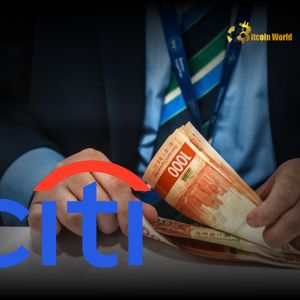Urgent: Hong Kong Dollar Nears Weak End Amid Citi Liquidity Drain Forecast
6 min read
BitcoinWorld Urgent: Hong Kong Dollar Nears Weak End Amid Citi Liquidity Drain Forecast For anyone keeping an eye on global financial stability and macro trends – crucial for understanding the broader landscape affecting even the cryptocurrency world – the current situation with the Hong Kong Dollar warrants close attention. The HKD is edging closer to the weak end of its tightly managed trading band against the US dollar, a move that signals underlying pressures in the market. This development is particularly significant following a recent Citi forecast highlighting a potential liquidity drain. Understanding the Hong Kong Dollar Peg Hong Kong operates a Linked Exchange Rate System, essentially pegging its currency to the US dollar within a narrow range. This system aims to provide stability, acting as a cornerstone of Hong Kong’s status as a global financial hub. Here’s a quick look at how it works: The Hong Kong Dollar is pegged to the US dollar at a rate of 7.80. There’s a trading band allowing the HKD to fluctuate between 7.75 and 7.85 per USD. When the HKD hits 7.85 (the weak end), the Hong Kong Monetary Authority (HKMA) is obliged to intervene by buying HKD from the market, which reduces HKD supply and supports its value. When the HKD hits 7.75 (the strong end), the HKMA intervenes by selling HKD, increasing supply and limiting appreciation. This mechanism means the HKD cannot deviate significantly from the 7.80 midpoint, providing predictability but also requiring the HKMA to align its monetary policy closely with the US Federal Reserve, or manage the consequences of divergence. Why the Citi Forecast Matters: Predicting a Liquidity Drain Citi’s recent analysis points towards a looming liquidity drain in the Hong Kong financial system. What does this mean, and why is it happening? Liquidity refers to the amount of readily available cash in the banking system. A drain means this cash supply is decreasing. Citi’s forecast is largely driven by the significant interest rate differential between Hong Kong and the United States. Consider this: The US Federal Reserve has aggressively hiked interest rates over the past couple of years to combat inflation. Because of the HKD peg , Hong Kong’s interest rates don’t automatically follow US rates step-for-step, although they are influenced. When US rates are significantly higher than HK rates, investors and businesses are incentivized to move funds from HKD assets to USD assets to earn a higher return. This flow of money out of HKD effectively drains liquidity from the system. Citi’s prediction suggests this differential is widening or is expected to widen further, accelerating the outflow and thus the liquidity drain. The movement of the HKD towards 7.85 is a direct symptom of this pressure. As funds leave the HKD system for higher yields elsewhere (primarily USD), demand for HKD falls relative to USD, pushing the exchange rate towards the weak end of the band. Implications of the Liquidity Drain on the HKD Peg A significant liquidity drain isn’t just an abstract financial concept; it has tangible effects, particularly for a pegged currency system like Hong Kong’s. Here are some key implications: Increased HKMA Intervention: As the HKD hits 7.85 more frequently or stays near it, the HKMA will need to step in more often to buy HKD. Each intervention reduces the banking system’s liquidity. Rising Interbank Rates: As liquidity is drained, the supply of HKD available for lending between banks decreases. Basic economics dictates that lower supply with stable or rising demand leads to higher prices – in this case, higher Hong Kong Interbank Offered Rates (HIBOR). Potential Economic Impact: Higher HIBOR can increase borrowing costs for businesses and individuals in Hong Kong, potentially slowing economic activity, impacting the property market, and increasing debt burdens. Pressure on the Peg: While the HKMA is committed to defending the peg, sustained and significant pressure from capital outflows and liquidity drain can test the system’s resilience and require substantial use of foreign exchange reserves for intervention. The current environment, marked by global economic uncertainty and divergent monetary policies, presents a notable challenge for the long-standing HKD peg . Navigating the Forex Market : What to Watch For those tracking global finance, including participants in the cryptocurrency space who often look to macro indicators, the situation in the Forex market involving the Hong Kong Dollar offers valuable insights. Here’s what to keep an eye on: Key Indicators: Monitoring the HKD/USD exchange rate itself is paramount, especially its proximity to 7.85. But other indicators provide deeper context: HIBOR Rates: Watch for increases in HIBOR, particularly the spread between HIBOR and LIBOR (or SOFR), as this reflects the tightening of HKD liquidity. HKMA Balance Sheet: Track changes in the HKMA’s Aggregate Balance, which is a direct measure of banking system liquidity. A shrinking Aggregate Balance confirms the liquidity drain. Capital Flow Data: While not always immediately available, reports on capital movements in and out of Hong Kong can indicate the scale of the pressure. US Fed vs. HKMA Commentary: Pay attention to statements from both central banks regarding their monetary policy stances and views on the economic outlook. Why This Matters Beyond HK: Hong Kong is a major financial hub connecting East and West. Stress on its currency system can have ripple effects: Regional Stability: It can influence confidence in other pegged or managed currencies in Asia. Capital Flows: Shifts in capital due to HKD pressure can impact asset prices elsewhere. Global Sentiment: Challenges to a long-standing peg can contribute to broader market uncertainty regarding financial stability. The current scenario is a real-world example of how global monetary policy divergence translates into tangible pressure on specific currency systems. The Citi forecast acts as a heads-up, signaling that these pressures are expected to continue, leading to a potentially significant liquidity drain . Actionable Insights for the Observer While direct trading in HKD may not be relevant for everyone, understanding this situation offers several actionable insights: Context for Macro Analysis: Use the HKD situation as a case study for how interest rate differentials and capital flows impact currency pegs and domestic liquidity. This knowledge is transferable to understanding dynamics in other markets. Indicator of Market Stress: The HKD nearing the weak end and the associated liquidity drain can be seen as an indicator of broader stress points in the global financial system driven by rising US rates. Impact on HK-based Assets: If you hold or are considering assets denominated in HKD (like certain stocks or funds listed in Hong Kong), be aware that rising HIBOR due to liquidity drain can affect company borrowing costs and consumer spending power, potentially impacting asset valuations. The situation is dynamic, and the HKMA has ample reserves to defend the HKD peg . However, the path of least resistance for the exchange rate in the near term appears to be towards the 7.85 limit, driven by the fundamental forces of interest rate differentials and the resulting liquidity drain as predicted by the Citi forecast . Conclusion The Hong Kong Dollar ‘s proximity to the weak end of its trading band is a direct consequence of global monetary policy divergence, particularly the gap between US and Hong Kong interest rates. The Citi forecast for a continued liquidity drain underscores the challenges facing the HKD peg . While the HKMA possesses significant resources to maintain the peg, the market dynamics are pushing the currency towards its limit, leading to tighter liquidity and potentially higher borrowing costs in Hong Kong. Tracking these developments in the Forex market provides valuable insight into the mechanics of pegged currencies and the broader implications of global capital flows and interest rate policies on financial stability. To learn more about the latest Forex market trends, explore our article on key developments shaping currency liquidity. This post Urgent: Hong Kong Dollar Nears Weak End Amid Citi Liquidity Drain Forecast first appeared on BitcoinWorld and is written by Editorial Team

Source: Bitcoin World



